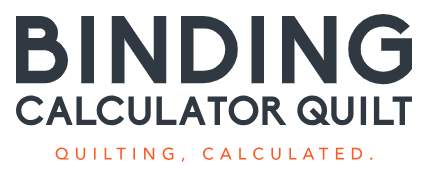Corner & Miter Calculator
Quilt Dimensions (before borders)
Mitered Borders
Straight grain borders are easier to cut but may require piecing for long strips
Fabric Settings
About Mitered Border Corners
What Are Mitered Corners?
Mitered corners are border corners where two strips meet at a 45° angle, creating a professional frame-like appearance. Unlike butted corners where one border simply overlaps another, mitered corners require precise cutting and sewing but result in a more elegant, polished finish.
Mitered corners are especially important for directional fabrics (like stripes or florals) because they allow the pattern to flow naturally around all four corners of the quilt without disrupting the visual flow.
Why Use Mitered Corners?
Benefits of Mitered Corners
- Professional appearance: Creates a picture-frame effect around your quilt
- Pattern continuity: Essential for directional prints and stripes
- Symmetry: All four corners look identical
- No bulk: Even distribution of fabric at corners
- Traditional technique: Used in fine quilting and heirloom pieces
When to Use Butted Corners Instead
- For beginner quilters still mastering basic techniques
- When using non-directional, busy prints where miter seams won't show
- For quick utility quilts where speed is more important than finish
- When working with very wide borders that make mitering difficult
Understanding Miter Geometry
All mitered corners on square quilts are cut at exactly 45°. This is because the corner of a square is 90°, and the miter line bisects this angle (90° ÷ 2 = 45°). The math is consistent regardless of border width.
Key Measurements
- Miter Allowance: Extra fabric needed at each end of a border strip, equal to the border width
- Miter Hypotenuse: The length of the 45° cut line, calculated as border width × √2 (approximately 1.414)
- Total Strip Length: Quilt edge + (2 × border width) + (2 × miter allowance)
Straight Grain vs. Bias Borders
Straight Grain Borders
Pros: Easier to cut, less fabric needed, more stable, less stretching
Cons: May require piecing for long strips, directional patterns may not align perfectly at miters
Best for: Non-directional prints, beginners, most quilts
Bias Cut Borders
Pros: Better for directional prints, easier to miter stripes, provides "give" for fitting
Cons: Requires significantly more fabric (up to 40% more), edges stretch easily, more difficult to handle
Best for: Striped fabrics, curved quilt edges, showpiece quilts
Common Miter Mistakes
Not stopping stitching at the exact seam allowance
Solution: Measure and mark ¼" from the corner before you start sewing. Some quilters place a pin exactly at this point.
Cutting the 45° angle incorrectly
Solution: Use a ruler with a 45° line, or use the corner of a square ruler. Double-check your angle before cutting.
Stretching borders while sewing or pressing
Solution: Pin carefully, sew with borders on top (against feed dogs), press gently without pulling.
Not matching centers
Solution: Mark the center of each border strip and each quilt edge. Pin centers together first, then ends, then ease in between.
Uneven border widths
Solution: Measure your quilt through the center (not along edges which may have stretched). Cut all four border strips before attaching any.
Working with Directional Prints
Directional fabrics (stripes, florals with a clear up/down direction) require special planning for mitered corners:
- Decide on pattern direction: Determine which way the pattern should flow on each side of the quilt (usually same direction on opposite sides)
- Add extra fabric: You'll need extra length to match patterns at miter seams, sometimes 6-12" extra per strip
- Cut borders carefully: Cut all four borders with the pattern running in your chosen direction
- Audition corners: Before sewing, lay out all four strips to see how patterns will meet at corners
- Match at miters: When drawing your 45° miter line, adjust so the pattern elements align on both sides of the miter seam
Note: For complex directional prints or stripes, consider using bias-cut borders which make pattern matching at corners much easier, though they require significantly more fabric.
Multiple Mitered Borders
When adding multiple mitered borders (like a narrow inner border and wider outer border), you have two options:
Method 1: Miter Each Border Separately
Add and miter the first border completely, then add and miter the second border.
Pros: Easier for beginners, each border independent
Cons: More seams, more time-consuming
Method 2: Sew Borders Together First
Sew border strips together lengthwise before attaching to quilt, then miter the combined unit.
Pros: Faster, fewer seams, borders perfectly aligned
Cons: Requires more skill, must handle wider strips
Tools for Perfect Miters
- Rotary cutter and mat: For accurate cutting of border strips
- Long quilting ruler: With 45° angle line marked (essential)
- Fine pins: To hold miter seams in place without distortion
- Marking pencil or pen: To draw the 45° miter line
- Iron and pressing surface: For careful pressing without stretching
- Square ruler: To verify corners are square after mitering
